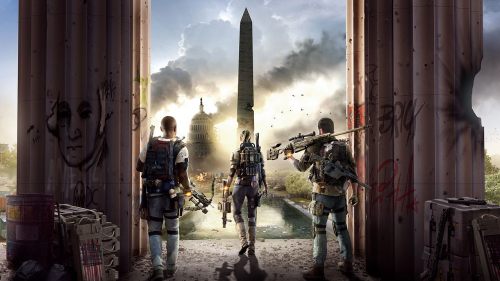PREY Game Review: I Am Become Coffee Cup, Destroyer Of Aliens
Prey is a better title than it is a franchise. The original 2006 underperformer bolted a couple interesting mechanics onto an otherwise cliche sci-fi shooter about Native American superpowers and butthole doors. Prey 2 was meant to be a semi-reboot, casting the player as a parkour-loving bounty hunter in a sprawling alien city; it never made it past trade shows. And now Prey is here, bearing zero resemblance to either of the previous games. New developer; new everything. The title’s the same, though. It’s a good title.
So Prey isn’t the Prey you probably didn’t play, or the Prey 2 you definitely didn’t play. But it won’t be unfamiliar, as developer Arkane borrowed from a wide range of games to produce its immersive sci-fi horror sim. At times, it’s very Half-Lifey; at others, BioShocky, System Shocky, Deus Exy, Dead Spacey and Metroidy; it even cribs liberally from Arkane’s own Dishonored (in developer talent as well as in game mechanics).
In describing Prey, it’s important to note that its protagonist is named Yu - reflecting both protagonist Morgan’s Asian background and the way the game’s mechanics prioritise player expression. Morgan’s clever-clogs naming is matched by his or her (you choose Yu’s gender) clever-clogs role in a space station-bound science programme, set in a 2032 where JFK wasn’t shot and the US space programme played out vastly differently. Naturally, however, Morgan and brother Alex’s (Benedict Wong!) science runs amok, unleashing a torrent of monsters seemingly made of darkness itself.
While Prey's narrative of technological hubris, extradimensional monsters, memory erasure, mind control, and psychotronic enhancements is as unoriginal as they come, how you go about moving through the story is refreshingly freeform - in a way that actually works. One-upping BioShock, there are multiple voices on your radio, each giving you conflicting instructions, but you don’t have to follow any of them urgently. Aside from a handful of mini-narratives, Prey's story has mostly already taken place before the fade-in. That means the main quest is mostly about dealing with aftermath, but it also means you're never guilt-tripped for exploring, or for pursuing sidequests. Good thing, too, because exploration is damned rewarding in Prey.
Space station Talos 1 is a fascinating place: varying architectural styles combined with weird sci-fi, seemingly designed to impress investors as much as to provide a space for living and research. Every room is filled with bespoke details, all of which support great narrative design. Between the environmental details, sidequests, and the immersive sim genre's ubiquitous emails, notes, whiteboards, and audio recordings, Talos 1 emerges as a community that once hummed with life, drama, and relationships. The station's crew is characterised variously through romance, paranoia, team-building exercises, ambition, sociopathy, and an adorably thorough subplot involving a friendly game of Dungeons and Dragons (or rather, a non-copyrighted D&D clone). When you encounter other living humans, it’s a real relief (often swiftly followed by other emotions), but poring over records of their lives is almost more absorbing.
Emphasising exploration is just one way Prey prostrates itself before the player. With a few exceptions, quests can be completed at any time, and the station can be explored in any order. The level design shunts players in its intended direction, but it's entirely possible to ignore that entirely, using abilities, equipment, and lateral thinking to get around. Locked doors aren't barriers so much as puzzles; areas that seem inaccessible can usually be reached with a bit of clever jumping and improvisation. It’s even possible to finish the game early, having only experienced a fraction of even the main quest.
While its weaponry is disappointingly basic for a sci-fi title - a pistol, a shotgun, a laser cannon - Prey does include a range of gear with more interesting applications. The Huntress Crossbow, effectively a Nerf gun, is useless in combat, but can remotely press buttons or touchscreen panels. The Gloo Gun, firing fast-drying liquid Styrofoam, is insanely versatile: it can incapacitate or slow down enemies, put out fires, seal hull breaches, or - best of all - create new, climbable paths around the environment. Early on, Morgan acquires a zero-g thruster system for her space suit, which provides extra lift and glide in normal gravity too. Finally, Morgan has a range of abilities - de rigeur for the genre - that can be upgraded with Neuromods, in-game items that rather unpleasantly inject into the brain via the optic nerve. Initially, these are skills like hacking, jumping, healing, and so on, but as the game progresses, you’ll gain access to supernatural powers nicked from the game’s spooky aliens.
Oh, yeah - Prey is also damned scary, as the overactive soundtrack constantly reminds you, thanks to its extradimensional “Typhon” aliens. One of the basic enemies, the tentacled Mimic, can physically imitate any in-game object, rendering every coffee cup a potential Schroedinger’s Monster. (Later on, you can acquire this ability for yourself, but it's less fun than you'd hope.) The resultant paranoia turns the game into an inanimate The Thing, with every object daring you to abuse the game’s quicksave function. Sadly, Mimics are at their most fun when in hiding: once they reveal themselves, they're simply hard-to-hit targets with constantly shifting centres of gravity - especially frustrating given the imprecise, stamina-draining nature of your basic melee weapon. Like Alien: Isolation's xenomorph, the closer you get to the Typhon, the more they become simple AI entities. After that, it’s just a gunfight.
Early on, the difficulty of the combat forces the use of alternate tactics, whether using your surrounding environment as a weapon or simply running away. But once you start upgrading your gear and powers, the combat gets easier, and it gets worse. Prey's late-game enemies suffer from poor AI and a lack of unique behaviours or defenses. Nothing approaches the ingenuity of Dead Space's limb-severing mechanic; the tougher enemies are essentially bullet sponges with the odd special ability. Making fights interesting is left up to you - laudable in a way, but too easy to ignore in favour of the tried and true. Even the game's toughest enemy, the “Nightmare,” was a total non-starter for me; initially, I'd simply hide under a desk and wait out its stalking timer, while later I’d down it quickly with several well-placed shotgun rounds. Alerts like “the Nightmare is hunting you” would be scarier if there was evidence it actually was; maybe it could learn from the other enemies, which would often glitchily notice me through solid walls.
Perhaps Prey's best innovation - and most weirdly addicting gameplay loop - comes as a response to one of gaming's most routinely irritating mechanics: resource management and crafting. Talos 1 is full of trash, which quickly fills your pockets if you pick it all up (and you will), but it also contains “Recyclers,” which break objects down into resources that stack conveniently in your inventory. With the grenade-like Recycler Charge, you can even recycle enemies and human bodies, like the ghoul you are. From the resultant blocks of resources, you can use “Fabricators” to 3D-print items like medkits, ammo, and even weaponry. So instead of mashing objects together to form others, you recycle them into base elements and fabricate new ones. Both tasks - accomplished by manipulating in-game machinery, rather than menu graphics - feel pleasingly tactile, turning what would otherwise be drudgery into an oddly enjoyable activity. Even item management is well-implemented, with your grid-based inventory sortable by name, item size, or type. Finally.
By the time it reaches its sudden, anticlimactic, narratively cheap conclusion, Prey tumbles from its wide-eyed, do-anything heights into a depressing, enemy-strewn slog. Its multiple concluding paths feel like a patch of glue on the pacing waterslide, just when things should be accelerating. Arkane also throws a great deal of thematic content at the player in the game’s final hours, exploring how memory affects the sense of self, but most of it gets lost in the rush to the finish line, lacking sufficient buy-in to Morgan’s character. And a post-credits scene piles on twist after twist that would have made more sense in the actual body of the game - twists that, as they are, feel like they actively undo much of your playthrough.
But that’s just the ending. The ultimate takeaway may be a dispiriting one, but the journey to it hits some pretty high highs. Borrowing a lot, but borrowing from the best, Prey has the skin and bones of a top-shelf immersive sim, even if its meat never quite lives up to it. Its emphasis on exploration makes for some wonderful, empowering moments of player cleverness, and its incidental writing is an absolute delight. But Prey gets brought down, ultimately, by the same problems that plague too many games: repetitive combat and a deeply unsatisfying main narrative. Now, if you’ll excuse me, I’m going to spend some time as a coffee cup. It seems rather preferable these days.



